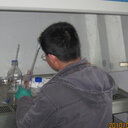Theoretical study of the mechanism of proton transfer in the esterase EstB from Burkholderia gladioli.
Ključne riječi
Sažetak
Esterase EstB from Burkholderia gladioli belongs to a novel class of esterases homologous to penicillin binding proteins, notably DD-peptidase and class C β-lactamases. It can cleave the side chain acetyl ester group from cephalosporins leaving the β-lactam ring intact, which is a feature of relevance to industrial biocatalytic applications in the production of semisynthetic cephalosporin derivatives. Due to its important role as a potential biocatalyst in industry, the significance of EstB has been greatly appreciated. However, the molecular basis for those residues involving catalysis of EstB remains elusive. By analyzing the crystal structure of EstB, we identified a conserved water molecule in active-site cavity which might mediate an intramolecular proton transfer (PT) from Lys78 to Asp186 via Tyr133. Then a combined computational approach including molecular dynamics (MD) simulations and quantum mechanics/molecular mechanics (QM/MM) calculations was employed to explore this presumable PT mode in the native enzyme. A 30 ns MD simulation of the enzyme highlights the conserved H-bond network involving Lys78, Tyr133, Asp186, and the conserved water molecule in the active site. In particular, the water molecule did not exchange with bulk solvent, indicating its structural and functional relevance. The energy profile calculated by QM/MM approach displayed a notably low PT barrier (2.2 kcal/mol) and a dramatic energy difference (14.1 kcal/mol) in reactants versus immediate products, which implies that the proposed proton shuttle is concerted and energetically favorable. Our studies offer a reasonable pathway to yield a free base by assisting Lys78 deprotonation, thereby paving the way for future studies on Ser75 activation that is a critical step in catalysis by EstB, as well as biocatalyst development by rational attempts. This PT mode would also afford clues for the forthcoming investigation on acyltransferase LovD that is homologous to EstB.




